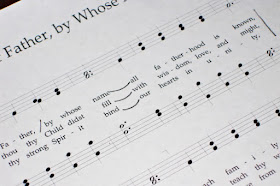Before deciding on fingerings, it's important to know when hands can be lifted and when they have to sustain notes. Therefore, the first step in marking a hymn is marking the text for breathing.
Why is breathing important?

As I mentioned in the "Breathing" article, which I highly recommend reading again:
As organists, we are called upon to enhance the worship of our congregation. It is very important that we study the text of the hymns and strive through proper registration and "breathing" to share the spirit of these hymns with the congregation.
If we don't do this, the meaning of the hymn can be lost amid awkward breaks, as in the Silent Night example I shared in that article:
All is calm,Makes much more sense than:
all is bright round yon virgin mother and Child.
All is calm, all is brightProper phrasing, or breathing, can mean the difference between members of the congregation feeling and understanding the message of the hymn, or just singing along with the organ.
Round yon virgin mother and Child.
Hymn 296, "Our Father, by Whose Name"

With Mother's day and Father's day coming up in the United States, hymn 296, "Our Father, by Whose Name," is a good hymn to study, as it talks about parents, children, and love in the home.
In this lesson we will analyze the text of each verse and decide how we want to phrase the text. You can use the hymn in your hymnbook, or print out a copy, then place it in a binder. If you'd like to print it, follow the link to the search results, click on the title, allow the new window to load, then click on the printer icon on the left-hand side.
Verse 1

Read through the first verse and decide the phrasing that will best share the message of the hymn with the congregation. This hymn is more poetic in nature, so the phrasing is more difficult than some. Here is my example, but your interpretation may vary:
Our Father, [very brief break in just the right hand]
by whose name all fatherhood is known,
Who dost in love proclaim each family thine own,
Bless thou all parents,
guarding well,
With constant love as sentinel, The homes in which thy people dwell.
The congregation will most likely want to breathe after "name" and "proclaim," among other places. Keeping the tempo close to 96 will help them sing each phrase without having to take a breath.
This phrasing is all well and good, but how do you mark the hymn this way?
/ - A slant after a word means a brief break in the right hand
| - A line after a word means a complete break in hand and feet
— - A long dash (an em dash) after a word means no break, or you can swoop the line if you'd rather

Verse 2
This verse is pretty straightforward:
As thou thy Child didst fill with wisdom, love, and might,
To know and do thy will and teach thy ways aright,
Our children bless, in ev'ry place,
That they may all behold they face,
And, knowing thee, may grow in grace.
Another option:
Our children bless, in ev'ry place, That they may all behold Thy face, /
And, knowing Thee, may grow in grace.
Verse 3

This verse can be interpreted a few different ways, but this is probably the simplest:
May thy strong Spirit bind our hearts in unity,
And help us each to find the love from self set free.
In all our hearts such love increase,
That ev'ry home, by this release,
May be the dwelling place of peace.
Homework
Choose this hymn or another one (or more) and mark it for breathing, keeping in mind the message of the hymn, in preparation for next week's lesson.
Continue practicing hymn 11, "What Was Witnessed in the Heavens?" and take the time to review the previous lessons, especially the ones dealing with manual technique.

In conclusion
Now that this hymn is marked for phrasing, or breathing, we know where we can lift our hand, and where we need to sustain the notes. Both of these things are essential when we decide on fingerings in part 3. We also know where we lift for one or more verses and sustain for one or more verses. With this knowledge we can continue on in our hymn preparation.
Continue on to Lesson 15: Marking a hymn, part 2.

No comments:
Post a Comment